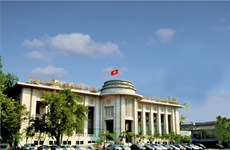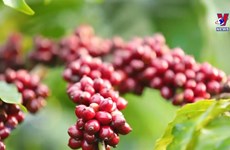Amended Constitution helps creating agricultural breakthroughs
Article 62 of the amended Constitution, which was adopted by the
National Assembly last year, has been praised by the scientific circle
for its greater emphasis on the role of science and technology in
national development, according to an analysis by the Nhan Dan (People)
online newspaper.
Article 62 of the amended Constitution, which was adopted by the
National Assembly last year, has been praised by the scientific circle
for its greater emphasis on the role of science and technology in
national development, according to an analysis by the Nhan Dan (People)
online newspaper.
Professor Nguyen Lan Dung provides some thoughts on the impact that the amended Constitution may have on the development of Vietnam’s agricultural sector.
A close look at Vietnam’s neighbours suggests that, several decades ago, they faced the same problems as Vietnam today, but thanks to advances in science and technology, the lives of their people have improved significantly. They are able not only to reduce the amount of imported goods but also to have excellent products for export, earning them a large influx of foreign currency.
A prime example is the Republic of Korea (RoK), which was not a member of the United Nations until 1991. From the ravages of war, this country has chosen the path of science and technology towards industrialisation and modernisation, including in agriculture.
With an area of approximate 140,000sq km (less than one third of Vietnam’s area) and a population of 48.9 million people (about half of Vietnam’s population), the RoK’s GDP per capita has reached 32,800 USD. Its total economic output is contributed mostly by services (57.5%), followed by industry (39.8%). Agriculture makes up just a small contribution of 2.7%. The proportion of the population engaged in agriculture is just 6.2%.
These figures show that the RoK has completed its industrialisation and modernisation in a very short time. In the 1960s, the RoK’s GDP per capita was only 80 USD, putting it on the same level of development with Ghana and Sudan, and lower than that of India. But decades later, the RoK has become a success story, after annual economic growth rates averaged 8% for the subsequent 40 years.
At a recent workshop organised by the Vietnamese Academy of Social Sciences, President of the Vietnamese Farmers’ Union Nguyen Quoc Cuong said that Vietnam is unlikely to fulfil the target of industrialisation and modernisation by 2020 because the level of Vietnam’s agricultural development, rural development and farmers remains far from requirements.
Currently, Vietnam’s GDP per capita by purchasing power parity is just 3,600 USD. The ratio of agriculture to total economic output is 19.7%, compared with 38.6% and 41.7% contributed by industry and services respectively. Nearly half of the workforce is in the agricultural sector.
In order to achieve the industrialisation and modernisation target in 2020, a major breakthrough in science and technology is needed to reduce the workforce in agriculture while improving the lives of farmers. The amended Constitution stipulates that, “the State prioritises and encourages organisations, individuals to make investments in the research, development, transfer and application of advances in science and technology; ensures the rights to conducting scientific and technological research; protects intellectual property rights. The States creates favourable conditions for everyone to participate in and enjoy the benefits of science and technology activities.”
Vietnam has a series of science and technology-related problems which have not been addressed, so despite being the world’s top rice exporter, the income of rice growers is much lower than that of other occupations. According to the Institute of Policy and Strategy for Agriculture and Rural Development (IPSARD), the proportion of farmers who have been given training on agricultural techniques reaches the ‘50% and above’ level in just three areas: plant seedlings, soil preparation and harvest techniques. Meanwhile, in other areas such as animal husbandry, product processing and storage, production management, market approach and climate change adaptation, the ratio of trained farmers is below 15%.
Figures on rice exports and animal feed imports in the first nine months of 2013 show two contrasting pictures. Rice exports fell in both volume and revenue compared with 2012, while animal feed imports rose substantially, with corn imports exceeding 1.33 million tonnes and soybeans surpassing 1 million tonnes. Vietnam’s title as the world’s top rice exporter bears no meaning when rice exports were largely offset by imports of other agricultural produce.
There are still many problems to be addressed in order to achieve real breakthroughs in the research, development, transfer and application of science and technology as stipulated in Article 62.
One of them is the science management mechanism, whose focus needs to be shifted from research input to research results and their application in reality. The re-organisation of agricultural research institutes and colleges and improvements to the capacity of scientists are also required.
At the same time, the Government should allocate more resources for scientific research in agriculture and develop long-term plans under which laboratories are required to conduct in-depth research into agricultural development.
Moreover, agricultural modernisation calls for enhancing the level of technology applied to areas such as rice growing, aquaculture and fishing, as well as replicating large-scale production models in which technology can be effectively utilised. Once these preparations are made carefully, science can be become a strong force to drive agriculture forwards.-VNA
Professor Nguyen Lan Dung provides some thoughts on the impact that the amended Constitution may have on the development of Vietnam’s agricultural sector.
A close look at Vietnam’s neighbours suggests that, several decades ago, they faced the same problems as Vietnam today, but thanks to advances in science and technology, the lives of their people have improved significantly. They are able not only to reduce the amount of imported goods but also to have excellent products for export, earning them a large influx of foreign currency.
A prime example is the Republic of Korea (RoK), which was not a member of the United Nations until 1991. From the ravages of war, this country has chosen the path of science and technology towards industrialisation and modernisation, including in agriculture.
With an area of approximate 140,000sq km (less than one third of Vietnam’s area) and a population of 48.9 million people (about half of Vietnam’s population), the RoK’s GDP per capita has reached 32,800 USD. Its total economic output is contributed mostly by services (57.5%), followed by industry (39.8%). Agriculture makes up just a small contribution of 2.7%. The proportion of the population engaged in agriculture is just 6.2%.
These figures show that the RoK has completed its industrialisation and modernisation in a very short time. In the 1960s, the RoK’s GDP per capita was only 80 USD, putting it on the same level of development with Ghana and Sudan, and lower than that of India. But decades later, the RoK has become a success story, after annual economic growth rates averaged 8% for the subsequent 40 years.
At a recent workshop organised by the Vietnamese Academy of Social Sciences, President of the Vietnamese Farmers’ Union Nguyen Quoc Cuong said that Vietnam is unlikely to fulfil the target of industrialisation and modernisation by 2020 because the level of Vietnam’s agricultural development, rural development and farmers remains far from requirements.
Currently, Vietnam’s GDP per capita by purchasing power parity is just 3,600 USD. The ratio of agriculture to total economic output is 19.7%, compared with 38.6% and 41.7% contributed by industry and services respectively. Nearly half of the workforce is in the agricultural sector.
In order to achieve the industrialisation and modernisation target in 2020, a major breakthrough in science and technology is needed to reduce the workforce in agriculture while improving the lives of farmers. The amended Constitution stipulates that, “the State prioritises and encourages organisations, individuals to make investments in the research, development, transfer and application of advances in science and technology; ensures the rights to conducting scientific and technological research; protects intellectual property rights. The States creates favourable conditions for everyone to participate in and enjoy the benefits of science and technology activities.”
Vietnam has a series of science and technology-related problems which have not been addressed, so despite being the world’s top rice exporter, the income of rice growers is much lower than that of other occupations. According to the Institute of Policy and Strategy for Agriculture and Rural Development (IPSARD), the proportion of farmers who have been given training on agricultural techniques reaches the ‘50% and above’ level in just three areas: plant seedlings, soil preparation and harvest techniques. Meanwhile, in other areas such as animal husbandry, product processing and storage, production management, market approach and climate change adaptation, the ratio of trained farmers is below 15%.
Figures on rice exports and animal feed imports in the first nine months of 2013 show two contrasting pictures. Rice exports fell in both volume and revenue compared with 2012, while animal feed imports rose substantially, with corn imports exceeding 1.33 million tonnes and soybeans surpassing 1 million tonnes. Vietnam’s title as the world’s top rice exporter bears no meaning when rice exports were largely offset by imports of other agricultural produce.
There are still many problems to be addressed in order to achieve real breakthroughs in the research, development, transfer and application of science and technology as stipulated in Article 62.
One of them is the science management mechanism, whose focus needs to be shifted from research input to research results and their application in reality. The re-organisation of agricultural research institutes and colleges and improvements to the capacity of scientists are also required.
At the same time, the Government should allocate more resources for scientific research in agriculture and develop long-term plans under which laboratories are required to conduct in-depth research into agricultural development.
Moreover, agricultural modernisation calls for enhancing the level of technology applied to areas such as rice growing, aquaculture and fishing, as well as replicating large-scale production models in which technology can be effectively utilised. Once these preparations are made carefully, science can be become a strong force to drive agriculture forwards.-VNA













